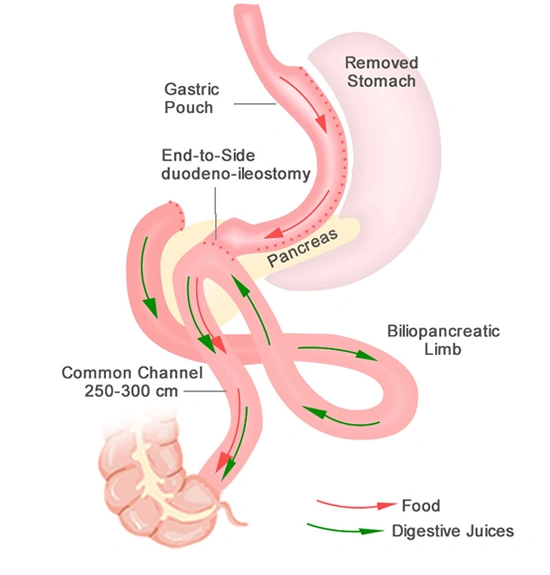In this type of procedure, part of the stomach is stapled shut to create a smaller cavity. The rest of the stomach is removed. Reducing the size of the stomach restricts the amount of food it can eat at one time. The small intestine is then divided, and only a very short section of its lower part is reconnected to the stomach.
By not using part (or most) of the small intestine, less food is absorbed.
Only a very short section of the intestine remains capable of absorbing food. Consequently, most of the food is excreted as excrement rather than absorbed as energy.


The SADIS technique combines three uses: treatment of super obesity, treatment of type 2 diabetes, and revision of Gastric Tube or Gastric Sleeve failure.
Its acronym SADI-S (Single anastomosis doudeno-ileal with sleeve gastrectomy) or translated, “Doudeno-Ileal Bypass, with Tubular Gastrectomy”, actually describes how this technique is performed.
SADI-S has been used as a conversion procedure for inadequate weight loss after RYGB. SADI-S has also been recommended for patients with weight regain or insufficient weight loss after SG, and there is a growing literature on the need for SG revisions and conversions. Some advocated for SADIs after a suboptimal SG outcome, which produced better and more reliable weight loss than other procedures, such as RYGB.
The SADI-S procedure is essentially a variant of the DS operation, in which the transected duodenum is anastomosed to a loop of ileum as opposed to the classic DS where a Roux-en-Y configuration is used. The SADI-S procedure was developed in part to reduce the complexity and therefore the risks of performing a Roux-en-Y configuration with small diameter distal bowel and the need for 2 anastomoses.
The ASMBS endorses the classic DS procedure (BPD-DS), and it is among the procedures the society believes meet appropriate standards of safety and benefit. Therefore, the SADI-S procedure, as a variant of the classic DS, merits consideration for ASMBS endorsement as a modification of an already approved metabolic/bariatric procedure.